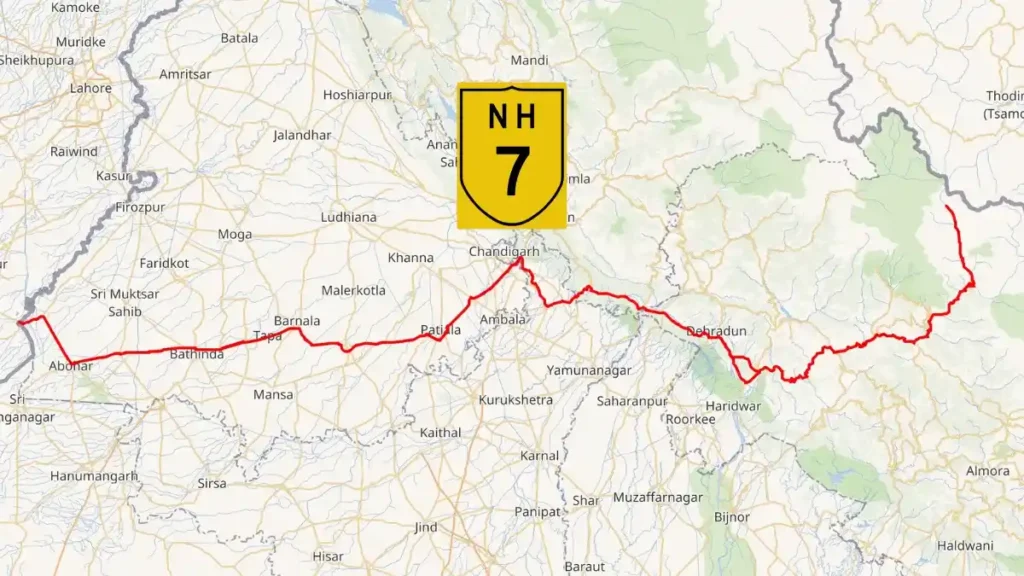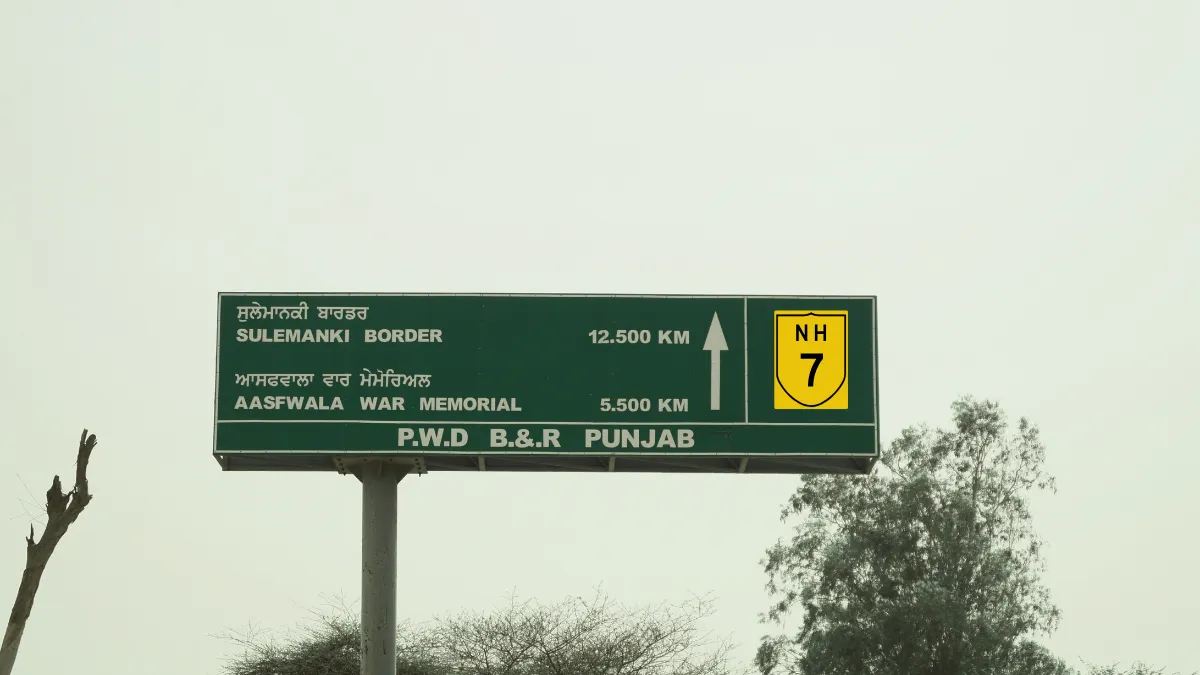NH 7 Set for Major Overhaul from Sulemanka Border to Mana
National Highway 7 (NH 7), a crucial artery stretching from the Sulemanka Border near Fazilka in Punjab to Mana in Uttarakhand, is undergoing a transformative upgrade as of April 2025. This ambitious project, spanning over 845 kilometers, aims to enhance connectivity across Punjab, Haryana, Himachal Pradesh, and Uttarakhand, promising safer and faster travel for millions of commuters, pilgrims, and traders.
The Public Works Department (PWD) has zeroed in on the initial 48.713-kilometer stretch from Sulemanka Border through Fazilka to Abohar, marking it as a priority for immediate improvement. However, while the vision is grand, progress has hit roadblocks, with delays in this key section raising concerns among locals and travelers alike. From bustling towns like Bathinda and Patiala to serene destinations like Rishikesh and Mana, NH 7 journey is one of both promise and patience.
A Vital Route Linking Borders to Mountains
NH 7 kicks off at the Sulemanka Border near Fazilka, a historic town just 10 kilometers from the India-Pakistan border, and weaves through Punjab’s agricultural heartland, including Abohar, Malout, and Barnala. It then passes through Sangrur and Patiala before reaching Zirakpur, a gateway to Haryana’s Panchkula, and continues into Himachal Pradesh via Paonta Sahib, eventually climbing to Uttarakhand’s spiritual hubs like Rishikesh, Rudraprayag, and Mana near the Indo-Tibet border.
This highway isn’t just a road—it’s a lifeline for commerce, tourism, and pilgrimage, connecting the plains to the Himalayas. The PWD current focus on the Fazilka-Abohar stretch (km 0.00 to 48.713) involves widening lanes and repairing worn-out surfaces, aiming to ease traffic snarls and boost safety. Yet, the slow pace of work has left many wondering when the full benefits will materialize.
Early Wins and Ongoing Struggles
The Sulemanka Border-Fazilka-Abohar section, though only a small part of NH 7 vast expanse, is critical for setting the tone of the upgrade project. Heavy traffic from trucks carrying goods and farmers transporting produce has long strained this two-lane road, leading to frequent accidents and delays. The PWD plans to expand it to four lanes, a move expected to cut travel time and improve road conditions significantly.
However, construction has been hampered by logistical challenges, including material shortages and coordination issues between state agencies. Local drivers report smoother patches where work is complete, but unfinished sections still feature potholes and dust, testing the patience of daily commuters. The PWD has pledged to accelerate efforts, targeting completion of this stretch by early 2026, though skepticism remains high among residents.
Economic and Cultural Impacts Await
Once fully upgraded, NH 7 stands to transform the regions it serves, starting with Punjab’s border towns like Fazilka and Abohar, known for their kinnow orchards and trade hubs. Improved roads could mean faster delivery of goods to markets in Bathinda, Barnala, and beyond, while cities like Patiala and Sangrur anticipate a boom in small businesses reliant on better connectivity. In Haryana, Panchkula’s proximity to Chandigarh could see increased traffic as a commercial corridor strengthens.
Further along, the highway’s path through Paonta Sahib in Himachal Pradesh and into Uttarakhand’s Rishikesh and Rudraprayag holds immense promise for tourism. Pilgrims heading to sacred sites like Badrinath and Hemkunt Sahib, accessible via Mana, will benefit from safer, quicker journeys. Still, until the Fazilka-Abohar stretch is fully operational, these gains remain a distant hope, tethered to the pace of construction.
Challenges on the Ground
Travelers on NH 7 today face a patchwork of experiences, especially in the early kilometers from Sulemanka to Abohar. Construction zones slow traffic to a crawl, with detours and uneven surfaces adding to the frustration of truckers and tourists alike. Beyond Punjab, the highway fares better in spots like Zirakpur and Paonta Sahib, where past upgrades have already smoothed the way, but the Himalayan stretches near Mana pose their own seasonal hurdles, like landslides and snow.

The PWD acknowledges these difficulties, pointing to weather disruptions and funding delays as key obstacles in the Fazilka-Abohar section. Commuters are urged to stay updated on road conditions, particularly in the initial 48.713 kilometers, where work crews remain active. Despite the setbacks, officials insist that the long-term vision—a seamless NH 7—remains firmly in sight.
Voices from the Roadside
Communities along NH 7 have mixed feelings about the upgrades, reflecting both optimism and impatience. In Fazilka, fruit trader Sunil Kumar welcomes the promise of wider roads but laments, “The dust and slow work hurt my deliveries—we need this done faster.” Meanwhile, in Malout, a truck driver named Harpreet Singh sees potential, noting, “Once it’s four lanes, I’ll save hours on every trip to Bathinda.”
In response, the PWD and NHAI have ramped up efforts, deploying additional resources to the Sulemanka-Abohar stretch and vowing transparency with regular progress reports. For now, locals and travelers alike are holding out hope that the highway’s transformation will soon match its ambitious blueprint, delivering on promises made to millions.
A Journey Through India Heart
NH 7’s route is as diverse as the nation itself, offering a blend of flat farmlands, urban sprawls, and towering mountains. From the border bustle of Sulemanka to the spiritual calm of Mana, it’s a highway that tells India’s story—one of trade, faith, and resilience. The upgrades, particularly in the Fazilka-Abohar stretch, are a crucial first step in ensuring this story continues to unfold smoothly for generations to come.
As the project progresses, NH 7 could become a model for India’s infrastructure ambitions, linking remote borders to sacred peaks with efficiency and care. For now, though, the focus remains on overcoming early hurdles, starting with those initial 48.713 kilometers that set the stage for everything to follow.
Looking Ahead to a Smoother Ride
The overhaul of NH 7 from Sulemanka Border to Mana is a bold step toward modernizing India’s road network, balancing today’s challenges with tomorrow’s rewards. While delays in the Fazilka-Abohar section have tested patience, the potential for safer, faster travel keeps the project’s momentum alive. As work continues, this highway’s evolution promises to reshape how people and goods move across four states.
For travelers, the message is clear: NH7 is on the cusp of change, and with each completed kilometer, the journey gets closer to its full potential. From Punjab’s plains to Uttarakhand’s peaks, the road ahead is one worth watching—and, soon, driving.
FAQs About NH-7 Upgrades from Sulemanka to Mana
Q: What is the scope of the NH 7 upgrade project?
A: The project covers NH 7 from Sulemanka Border near Fazilka to Mana in Uttarakhand, spanning 845 kilometers. It includes widening lanes and improving surfaces, starting with the Fazilka-Abohar stretch (km 0.00-48.713).
Q: Why is the Fazilka-Abohar section a priority?
A: This 48.713-kilometer stretch sees heavy traffic and frequent accidents due to narrow lanes. Upgrading it to four lanes aims to enhance safety and reduce congestion for commuters and traders.
Q: What’s causing delays in the Fazilka-Abohar upgrades?
A: Material shortages, weather disruptions, and coordination issues have slowed construction. The PWD is working to resolve these and targets completion by early 2026.
Q: How will NH 7 upgrades benefit tourism?
A: Better roads will ease travel to pilgrimage sites like Rishikesh, Rudraprayag, and Mana, boosting visitor numbers. This could lift local economies in Himachal Pradesh and Uttarakhand significantly.
Q: What challenges do drivers face on NH 7 now?
A: Construction in Fazilka-Abohar causes detours and slowdowns, while Himalayan sections near Mana face landslides and snow. Completed areas like Zirakpur offer smoother travel already.

